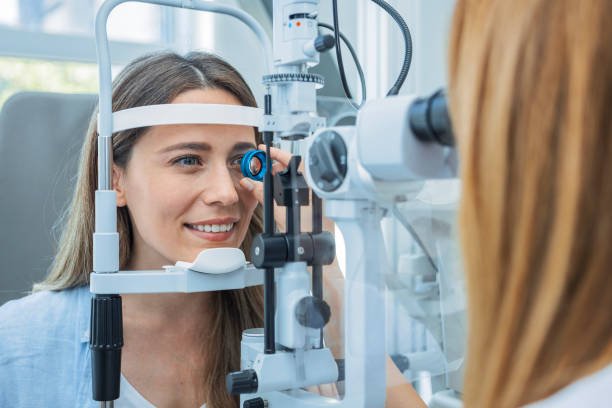10 Steps to Get the Most Out of Your Eye Test
Embracing a Clearer Vision: The Future of Eye Examinations
In this digital age, are we still bound by the traditional brick-and-mortar experience when it comes to eye exams? Are you still content with the old school dilation process and the bulky machines looming over your face? Or, can we open our eyes to a world where innovative technology enhances our eye test experience? This blog post explores cutting-edge technologies that are transforming the eye test experience, rendering it more accurate, efficient, and comfortable.
Advancements in technology have infiltrated virtually all aspects of our lives, making tasks easier and more efficient. So why would the process of eye examinations be left behind? Grab your cup of coffee as we delve onto a compelling journey of exploration. Let's cast our eyes on the captivating world of optical technology as it unfolds before our very eyes, reinventing the understanding of vision health.

From artificial intelligence and virtual reality to telemedicine, we will explore the many ways technology is refining, evolving, and essentially reshaping the experience and the process of eye tests.
Getting the most out of your eye
test is important for maintaining good eye health and ensuring you have the
correct prescription if needed. Here are ten steps to help you make the most of
your eye test:
1. Schedule Regular Eye Exams: Schedule regular eye test even if you don't currently experience vision problems. A routine eye exam can detect issues early, making them easier to manage or treat.
2. Choose the Right Eye Care Professional: Depending on your needs, you may see an optometrist or ophthalmologist. Optometrists can provide general eye care and prescribe glasses or contact lenses, while ophthalmologists are medical doctors specializing in eye health.
3. Prepare for Your Appointment: Before your appointment, make a list of any symptoms or issues you've been experiencing, including changes in vision, eye discomfort, or family history of eye conditions.
4. Bring Your Glasses or Contact Lenses: If you already wear glasses or contact lenses, bring them with you to the appointment. Your eye care professional may want to check your current prescription.
5. Discuss Your Lifestyle and Needs: Be sure to discuss your lifestyle and visual needs with your eye care professional. Mention if you spend a lot of time on a computer, need prescription sunglasses, or engage in any hobbies or activities that may affect your eyes.
6. Ask Questions: Don't hesitate to ask questions during the exam. It's important to understand any conditions, prescriptions, or recommendations your eye care professional provides.
You Must Watch: When Is Speech Therapy Most Effective
7. Undergo Comprehensive Testing: A thorough eye exam should include tests for visual acuity, eye pressure (for glaucoma screening), dilated eye examination, and other specialized eye test based on your age and risk factors.
8. Discuss Eye Health: Ensure that your eye care professional checks for eye health conditions, such as cataracts, macular degeneration, diabetic retinopathy, or signs of other diseases that can affect your eyes.
9. Review Prescription Options: If your prescription has changed, discuss your options for eyeglasses or contact lenses, including lens materials, coatings, and frames that best suit your needs and style.
10 Follow Recommendations: If your eye care professional recommends treatment, such as prescription eyewear, eye drops, or further testing, follow their advice and treatment plan to maintain or improve your eye health.
Remember that eye test are not just for those with vision problems; they are essential for preventive eye care. Regular eye exams can help detect and address eye issues early, potentially preventing more serious problems down the line. Taking these steps will ensure that you get the most out of your eye test and maintain optimal eye health.
Eye Test Innovation One: Artificial Intelligence
In an era where AI has permeated into countless industries, it's gaining significant traction in the field of optometry too. AI has the potential to revolutionize traditional eye examinations in a multitude of ways. This technology can assist ophthalmologists and optometrists in detecting and diagnosing eye conditions, planning treatments, and even predicting future issues before symptoms even arise.

AI's power lies in its ability to scan and analyse patterns within extensive data sets. For eye health, this translates into accurately detecting potential problems by analysing retinal images and identifying patterns that may signify an issue. Even more impressively, AI can use these patterns to predict the likelihood of future eye diseases, prompting preventative action and offering an exciting glimpse into a possible future of proactive eye health management.
However, AI isn't without its challenges. Much like other medical fields, ethical and privacy concerns surrounding the use of AI in eye care remain at the forefront. Despite concerns, the considerable benefits it can bring to early disease intervention and the overall improvement of eye care cannot be discounted.
Conclusion
As we return from our exploratory journey into the innovative world of eye examinations, it becomes clear that technology is undeniably reshaping and refining the way we approach ocular health. Whether it's through AI or VR, the technological advancements promise a future where eye tests are more accurate, efficient, and ultimately more accessible.
There's no denying that these innovations still come packaged with their set of challenges. Privacy, ethics, and accessibility debates abound, but one thing remains certain, technology is radically changing the conventional eye test process.
As we continue to embrace these
advancements, eye care is inherently transitioning towards proactive health
management, offering a possibility to detect eye diseases even before they
manifest. This undoubtedly opens the door to a future where sight loss could be
significantly reduced and even eradicated. In the grand kaleidoscope of
technological development, this is but one facet, a small but significant piece
that makes a marked difference in the field of eye health.



0 comments
Note: only a member of this blog may post a comment.